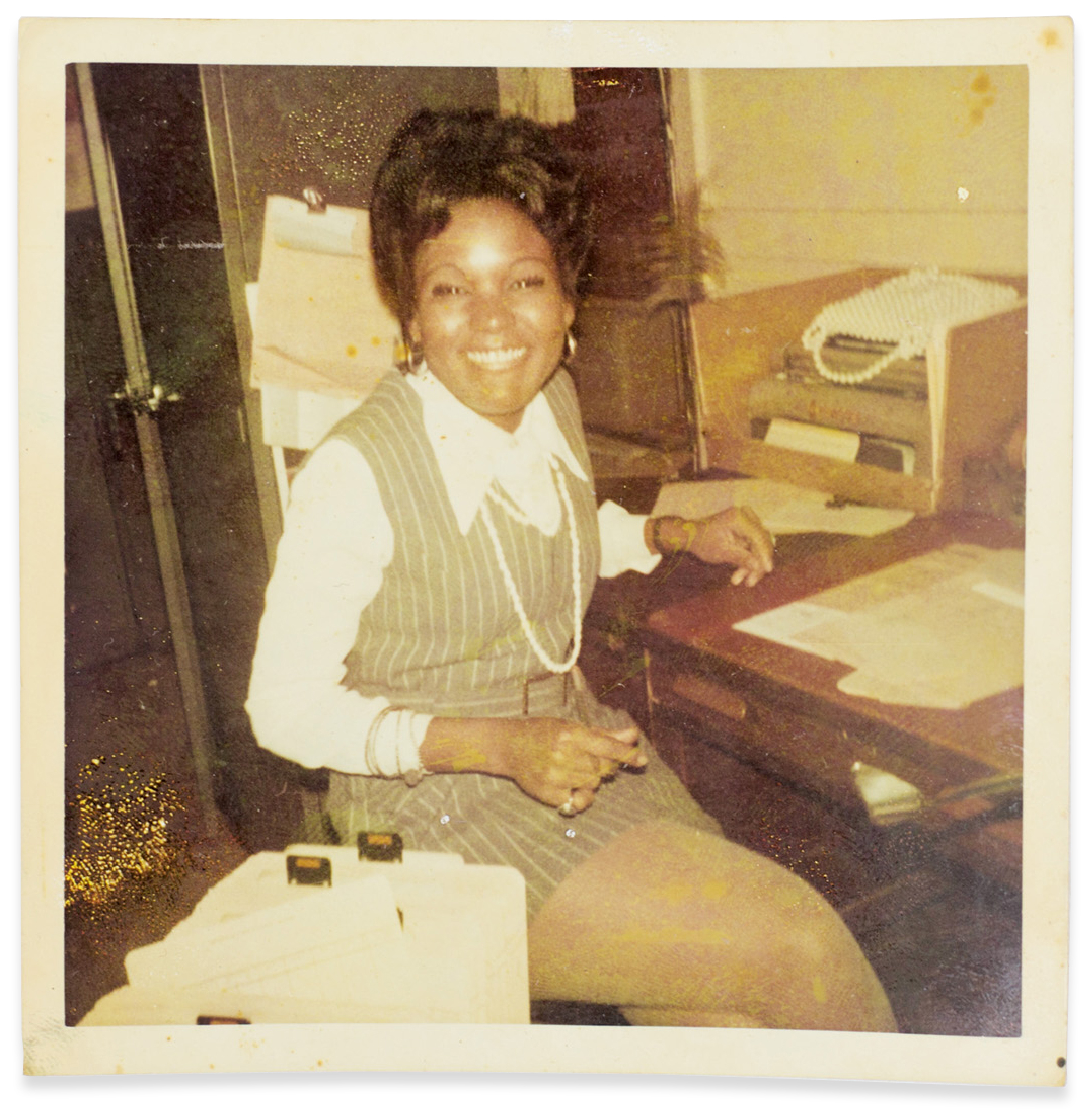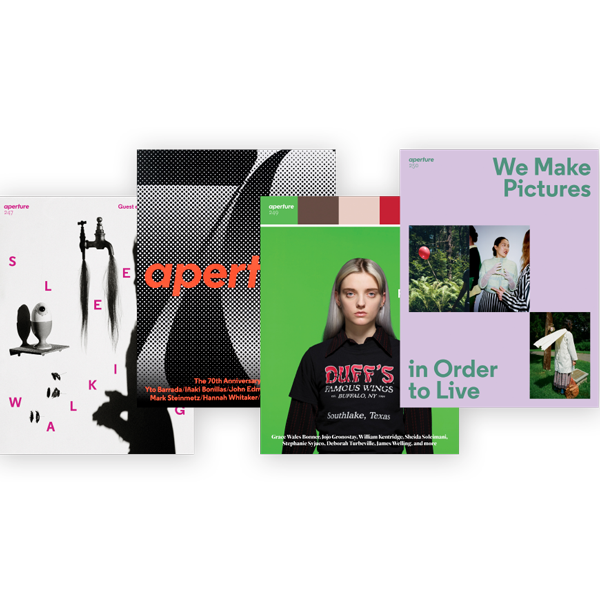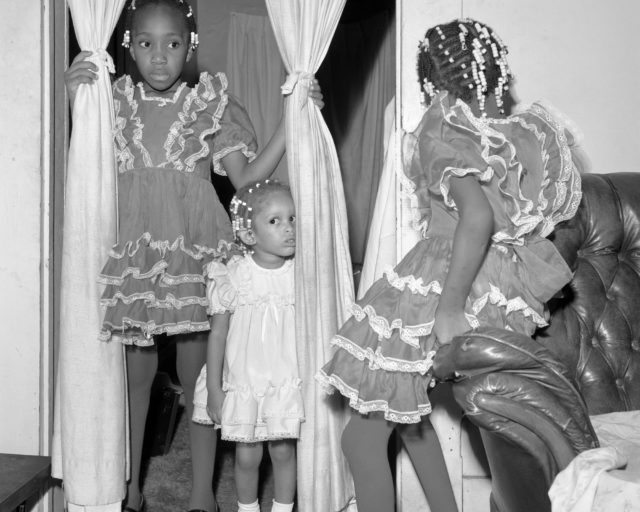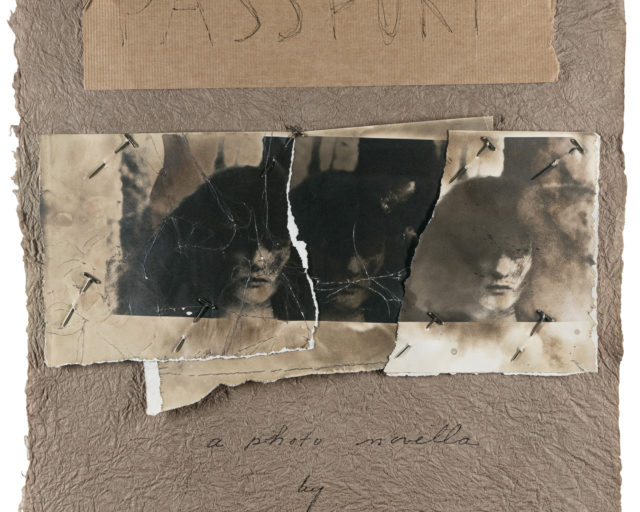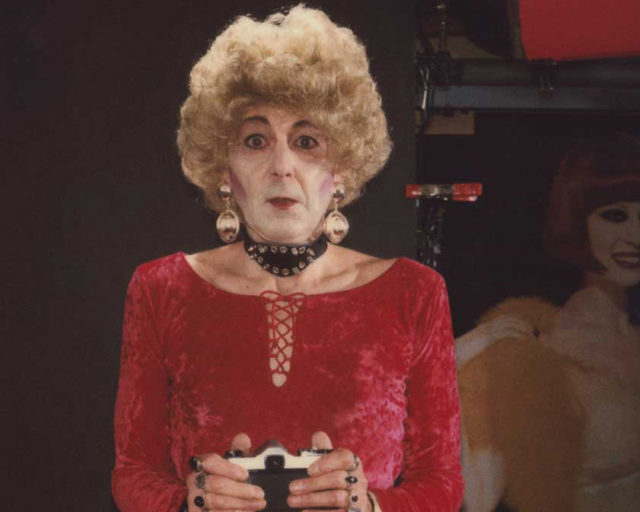Qiana Mestrich, Mom’s bright smile at the offices of Rugol Trading Corporation in Tribeca, New York, ca. 1969
Archival images can find us in the most discreet and serendipitous ways—stashed in a forgotten book, orphaned at a flea market, tucked in the sleeves of a photo album. Their scenes are portals to a different time, and often, with patience, they are a compass for our present one. At least this is how the artist Qiana Mestrich thinks and speaks of them. Her series Toward a History of Women of Color in the Workplace (2018–ongoing) is a result of the artist’s search for answers about her past and her place as a mixed-race person in the United States. She found these images—a collection of prints from around 1969, when her mother worked as a secretary—among her family’s belongings, wrapped inconspicuously in plastic pharmacy bags.
Sifting through them struck a chord: “I enjoyed going to work with her as a child when I had days off from school,” Mestrich says of her mother, Lydia, who raised her alone, “so it was fascinating to see this visual record of her first office job.” Inspired, Mestrich talked to her mother about the images, tried to track down the photographer, and became engrossed with contextualizing them.
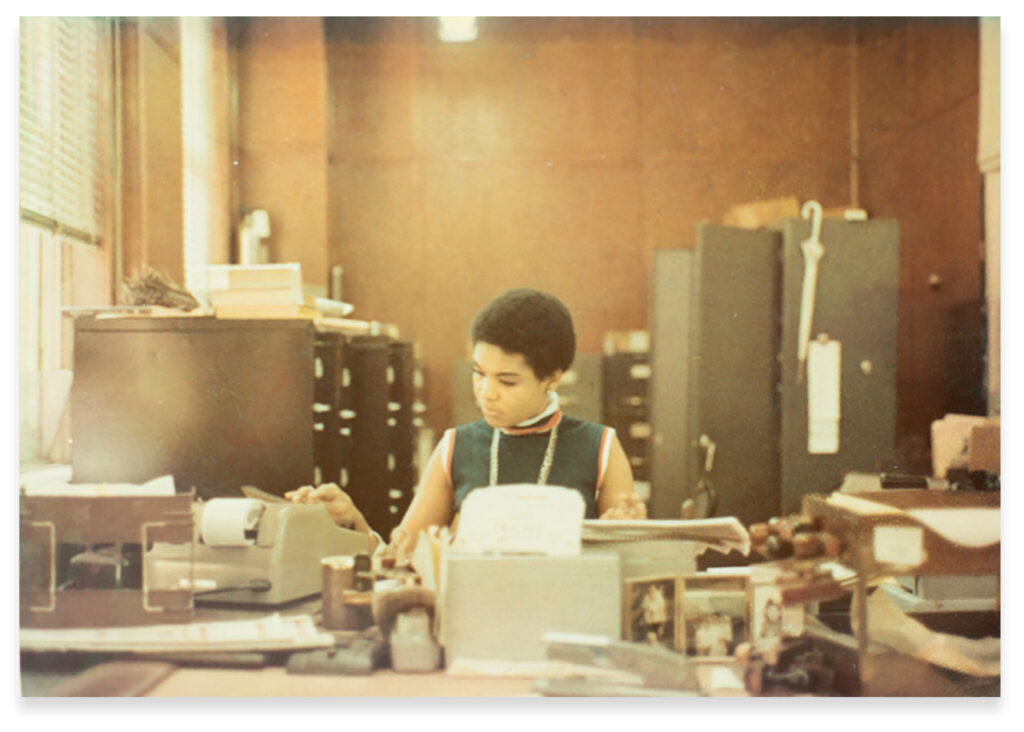
The photographs helped Mestrich feel closer to her mother, who emigrated from Panama to the United States in 1969, in her early twenties. When Lydia arrived in New York, she found an opening on the assembly line at a perfume factory. The work was grueling, and she didn’t stay for long. Through a friend from her English classes, Lydia got a job as a secretary at Rugol Trading Corporation. “She quickly had to be independent,” Mestrich notes of Lydia’s early days in the city. “She made this community of girlfriends who were all immigrants from Latin America, and they were all in the same boat of trying to make it on their own.”
Rugol, a wholesale hardware company, no longer exists. Its former office building, at 55 North Moore Street, has been converted into million-dollar co-ops. And the neighborhood it once called home—Tribeca—is now more famous for luxury lofts and restaurants than warehouses. Mestrich’s series captures a transitory phase in the area’s past—after the demise of commercial outlets and factories but before it became an artists’ haven and, later, a bastion of wealth. They show her mother and her colleagues working and milling about in an industrial workshop turned office space. In one photograph, provisional walls separate each employee’s desk area and fluorescent lights dangle from the high ceilings. A white column plastered with a baseball poster—Mestrich’s mother is a fan of the sport—interrupts the flow, another reminder of the space’s makeshift nature. “It wasn’t built to be an office,” Mestrich says to me as we huddle over her laptop. She points out Lydia, hunched over a desk in the far-left corner, and then her mother’s coworker, fiddling with a typewriter.
Another photograph of Lydia—this time smiling while seated at her desk—expands the office topography. Behind her stands a row of green-tinted filing cabinets and two-door storage closets. Precariously stacked reams of paper sit on top of some, while others display notes held up with magnets. Lydia smiles warmly at the camera, her hands clasping a document. These images convey a familiarity between subject and photographer. Lydia told Mestrich that they were taken by her coworker, an African American man who worked in the mail room. (Mestrich has tried to get in touch with him but hasn’t yet been successful.) He would happen upon his colleagues, sometimes asking them to pose, other times snapping candids. His proximity to his subjects lends the photographs an affectionate warmth. They are the kind of pictures friends take of one another, endearing attempts to capture the ephemeral.
How does spending time with the archive enhance our understanding of the role women of color play in the workplace—yesterday, today, and tomorrow?
In that same photograph of Lydia at her desk, follow the trail from her slender fingers to her earlobe and you can see a thick band of bracelets decorating her wrist, then a globular gold earring. Mestrich takes joy in observing her mother’s style, which serves as a window into late 1960s fashion. This was the era of the Black Power movement, “Black is beautiful,” Woodstock, and the Harlem Cultural Festival. The photographs in the series reflect Lydia’s elegance and her varied wig collection. In some images, she wears her natural hair coiffed into an Afro, in others, she dons a tall wig with a chic side part. Fellow employees have similarly sophisticated garbs. Take the photograph in which Lydia’s coworker nibbles on a piece of birthday cake: See the coworker’s outfit, a checkered dress cinched at the waist with a wide belt. Look at Lydia, seated at her desk, in a white collared button-down under a gray dress. A string of pearls hangs from her neck, connecting the two garments.

Courtesy the artist
Toward a History of Women of Color in the Workplace begins with Lydia, but Mestrich doesn’t want it to end there. The time she has spent with her mother’s archive has inspired more questions about the professional legacy of women. She thinks of the 1980 film 9 to 5, its vision of office spaces including no one who isn’t white, and compares that to her mother’s reality and her own as a working artist. I can’t help but think of Mestrich’s project alongside Ling Ma’s, Raven Leilani’s, and Natasha Brown’s novels, works that have, in recent years, tried to capture the office experiences among women of color. In the spirit of tethering archives to a community, Mestrich, a recipient of the 2022 Magnum Foundation’s Counter Histories grant, has started an Instagram account for these photographs. She hopes they will inspire others to submit family pictures of working mothers, aunts, and grandmothers. “We are the backbone of these companies,” Mestrich says.
If there is a broader goal for the series, it’s to possibly answer questions about gender discrimination, pay discrepancies, and the continued lack of representation of Black women in leadership roles: What can images from 1969, or throughout the past century, tell us about the contemporary moment? How does spending time with the archive enhance our understanding of the role women of color play in the workplace—yesterday, today, and tomorrow?
This article originally appeared in Aperture, issue 249, “Reference.”










